#MG Comet EV Interior
Explore tagged Tumblr posts
Text

Improved Durability: Analysts have been centring on progressing the solidness of Vantablack. The most recent details gloat expanded resistance to natural components, making them more reasonable for long-term utilize in different businesses. This seems to open entryways for applications in engineering and open-air establishments.
#mg comet ev#mg comet ev price#mg comet ev interior#mg comet ev price in Noida#mg comet ev price in india#mg comet ev range#mg comet evon road price#mg comet ev on road price in noida#2024 mg comet ev charging#mg comet ev mileage#comet ev price#mg comet ev range in km#mg comet ev car#mg comet ev top speed#mg comet Wheelsbingo#Wheelsbingo
0 notes
Text
MG Launches Game-Changing Comet EV in India - A Tiny Electric Wonder with Big Features at an Unbeatable Price!
Rev up your engines, India! MG has just launched the all-new Comet EV - a compact electric vehicle that's small in size but big on features. With a 230km range and a base price of just Rs 7.98 lakh. #MGCometEV #ElectricRevolution #CometEv #MGIndia #ev
MG introduces the Comet EV in India, a compact three-door electric vehicle with a 230km range and a base price of Rs 7.98 lakh. The Comet EV offers an impressive list of features, including a 10.25-inch infotainment system, wireless Android Auto and Apple CarPlay, and a full-width LED light bar, making it a top contender in the city runabout segment. The Comet EV is priced at Rs 7.98 lakh…

View On WordPress
#auto news#mg comet ev#mg comet ev colours#mg comet ev interior#mg comet ev price#mg comet range#NEWS
0 notes
Text
MG EV Car Price in Chennai: A Complete Guide for Buyers
The expansion of electric vehicles (EVs) in India has propelled MG Motor to become a top brand in the EV segment. The electric vehicles produced by MG feature their distinctive future-oriented design principles tied to their performance elements along with environmental-friendly characteristics. Before purchasing an MG EV you need to understand the Chennai-based pricing structure along with all price-determining factors.
Why Choose an MG EV?
MG Motor implements engineering principles that combine sustainable design qualities and exceptional operational efficiency into its EV models. Here’s why they stand out:
Zero Emissions: You can help our environment by lowering carbon emissions.
Lower Running Costs: The operational costs of electric vehicles remain low while their maintenance needs remain reduced.
Advanced Technology: The driving experience gains benefits from three advanced system functions: AI-infotainment assists and connected solutions and regenerative braking technology.
Smooth Performance: The vehicle delivers immediate torque power combined with whisper-quiet operation to create a perfect ride experience.
MG EV Models and Their Prices in Chennai
MG offers two prominent electric vehicles in the Indian market:
MG ZS EV
Price: Starting from ₹23 lakh (on-road Chennai)
Key Features: This advanced electric SUV delivers 461 km of range during each charge while offering a big interior and strong battery performance.
MG Comet EV
Price: Starting from ₹9 lakh (on-road Chennai)
Key Features: A compact and stylish EV ideal for city driving with an impressive range and smart features.
Factors Affecting the MG EV Car Price in Chennai
When purchasing an MG EV, several elements influence the final on-road price:
Government Subsidies & Incentives: Buyers receive tax relief and other valuable benefits from the Tamil Nadu government because they purchase electric vehicles.
Insurance Premiums: The final price of an MG EV depends heavily on the purchase of complete insurance coverage.
Charging Infrastructure Costs: MG offers electric vehicle charging solutions but home-based charging station installation increases the total cost.
Additional Accessories & Features: Premium accessories for the MG EV will elevate its price when you customize it.
Benefits of Owning an MG EV in Chennai
Chennai shows ongoing support for electric vehicles which makes it a perfect market to own an electric car. Here’s why:
Expanding Charging Network: Public charging stations in Chennai are growing at an increasing rate to provide improved accessibility.
Reduced Road Taxes: Tamil Nadu grants tax relief for electric vehicle owners because the state seeks to promote electric vehicle usage.
Lower Fuel Costs: Electricity produces lower total ownership costs than traditional fuels due to its cheaper prices so EVs represent more affordable vehicles over the years.
Sustainable Future: Driving an MG EV helps you add to an environment that is both green and clean.
Conclusion
The cost of the MG electric vehicle determines by model selection and incentive application and pricing of additional components in Chennai region. When you choose between the spacious ZS EV and the compact Comet EV you obtain valuable sustainability and budget savings for your transportation needs. Check out MG Chennai showrooms today to review their new electric vehicle line-ups with a test drive then start your transition toward eco-dedicated motoring.
0 notes
Text
List of India’s Best Electric Cars Under 10 Lakhs 2024

The automotive industry in India is experiencing a revolution with the rise of electric vehicles (EVs), especially those priced under 10 lakhs. These budget-friendly EVs are not only environmentally friendly but also offer a compelling alternative to traditional combustion engine vehicles. Let's take a closer look at some of the best electric cars available in this segment:
Strom R3: Strom Motors introduces the R3, a compact electric car designed for urban commuting. With a range of around 200 km on a single charge, the R3 offers impressive efficiency and speed, making it ideal for city driving. Its retro-inspired design and urban-friendly maneuverability set it apart in the market.
PMV EaS E: The PMV EaS E stands out with its innovative design and safety features. Boasting a range of up to 160 km on a single charge, it offers a comfortable and connected interior with modern amenities. Its commitment to eco-friendliness makes it a compelling choice for those looking to minimize their carbon footprint.
MG Comet EV: Crafted by MG Motor, the MG Comet EV combines style with sustainability. With a range of up to 230 km on a single charge and fast-charging capabilities, it offers both practicality and convenience. Luxurious interior features and advanced safety measures further enhance its appeal.
Tata Tiago EV: Tata Tiago EV emphasizes sustainability in urban commuting with its sporty design and modern features. With a claimed range of up to 315 km on a single charge and efficient charging options, it offers a comfortable ride and low running costs, making it an eco-friendly option for city dwellers.
Mahindra E Verito: Introduced by Mahindra & Mahindra, the Mahindra E Verito is a dynamic electric sedan designed for efficient urban mobility. With a range of 110 km on a single charge and feature-rich interior, it offers both performance and practicality. Its eco-friendly design and cost-effectiveness make it a standout choice in the market.
In conclusion, the availability of budget-friendly electric cars under 10 lakhs is transforming the landscape of sustainable commuting in India. With advanced technology, impressive mileage, and competitive pricing, these EVs cater to the needs of eco-conscious consumers while also addressing budget constraints. Embracing these options represents a significant step towards a greener automotive future in the country.
To read more, click here.
#Best Electric Cars Under 10 Lakhs 2024#Best EV Cars Under 10 Lakhs 2024#Electric Cars Under 10 Lakhs#Best Electric Cars 2024
0 notes
Text
"Unveiling India's Electric Car Revolution: Discover the Game-Changers, from MG Comet EV to Tata Nexon EV on World EV Day!"
India celebrated World EV Day with the spotlight on the most cost-effective electric cars available in the country. Amidst the range of options, the MG Comet EV and Tata Nexon EV emerged as the standout choices. The MG Comet EV garnered attention for its affordability and eco-friendly features. Equipped with advanced technology and a spacious interior, this electric vehicle offers a comfortable…

View On WordPress
0 notes
Text
"Unveiling India's Electric Car Revolution: Discover the Game-Changers, from MG Comet EV to Tata Nexon EV on World EV Day!"
India celebrated World EV Day with the spotlight on the most cost-effective electric cars available in the country. Amidst the range of options, the MG Comet EV and Tata Nexon EV emerged as the standout choices. The MG Comet EV garnered attention for its affordability and eco-friendly features. Equipped with advanced technology and a spacious interior, this electric vehicle offers a comfortable…

View On WordPress
0 notes
Text
"Unveiling India's Electric Car Revolution: Discover the Game-Changers, from MG Comet EV to Tata Nexon EV on World EV Day!"
India celebrated World EV Day with the spotlight on the most cost-effective electric cars available in the country. Amidst the range of options, the MG Comet EV and Tata Nexon EV emerged as the standout choices. The MG Comet EV garnered attention for its affordability and eco-friendly features. Equipped with advanced technology and a spacious interior, this electric vehicle offers a comfortable…

View On WordPress
0 notes
Text
The Indian electric car market has entered the stage of business process re-engineering after the launch of the MG Comet EV

MG Comet EV Launch -THE NO-NONSENSE CAR -EX SHOWROOM 7.98LAC MG has recently introduced the Comet EV, a modern electric vehicle that draws inspiration from the classic MG Comet sports car. The Comet EV is now available for purchase in India, with an introductory starting price of Rs 7.98 lakh (ex-showroom).

Designed for urban driving, the Comet EV boasts a single motor that provides 42 horsepower and 110 Nm of torque. The car also features a 10.25-inch touchscreen infotainment system, making it a tech-savvy choice for drivers who appreciate cutting-edge features. Test drives for the Comet EV will be available starting April 27, and interested buyers can book the car starting May 15. Deliveries are expected to begin later in the same month. With its compact size and eco-friendly electric powertrain, the MG Comet EV is poised to appeal to Indian drivers looking for an efficient, stylish, and practical city car. Interior Stepping inside the MG Comet EV, you'll find a clean and modern white and

grey interior. The cabin is centred around two 10.25-inch screens, one for the infotainment system and the other for the digital instrument cluster. This high-tech setup adds to the car's futuristic appeal and provides easy access to all the necessary information while on the go. The front passenger seat of the Comet EV features a one-touch tumble and fold feature, making it easy to configure the space for maximum convenience. The rear seats have a 50:50 split, allowing for flexible seating arrangements depending on your needs. The car also features a rotary drive selector, adding a touch of elegance to the driving experience.

The Comet EV offers a range of convenient features, including wireless Android Auto and Apple CarPlay, manual AC controls, keyless entry, steering-mounted controls, and three USB ports. Additionally, the car boasts over 55 connected features, ensuring you stay connected and in control on the road. Safety is a top priority for the MG Comet EV, which features ABS, EBD, tyre pressure monitoring system (TPMS), a reverse camera and sensors, as well as dual front airbags. These features provide peace of mind and ensure that you and your passengers stay safe and secure while travelling.

Overall, the MG Comet EV offers a sleek and modern interior packed with advanced features designed to make your driving experience as comfortable and convenient as possible, all while ensuring your safety on the road.

Exterior Taking inspiration from the Wuling Air EV, the MG Comet EV sports a boxy design that sets it apart from other

electric vehicles on the market. One unique feature is the full-width LED light bar, which MG calls the Extended Horizon connecting lights. This design element adds to the car's futuristic appeal, and the strip of chrome and piano black that connects the wing mirrors adds a touch of sophistication. The Comet EV features a front-mounted charging port that's housed beneath the light bar, and its flap has an illuminated MG logo, which is a neat touch. The car rides on 12-inch alloy wheels, which are the smallest wheel size currently available in the market. Additionally, the Comet EV has an asymmetrical window design with the rear windows mounted vertically, adding to its distinctive look.

At the rear of the car, the Extended Horizon connecting lights make another appearance, adding to the car's overall cohesive design. The Comet EV comes in five different colours, and there are multiple graphics packs available, categorised under sticker styles and lit packs. In summary, the MG Comet EV boasts a unique design with interesting touches that make it stand out from other electric vehicles. Its futuristic appeal and small footprint make it an ideal choice for city driving, while its range of colours and graphics options allow for personalisation to suit individual tastes. Battery and other features

The MG Comet EV is powered by a 17.3kWh battery that boasts an IP67 rating for water and dust resistance. This advanced battery technology provides an impressive ARAI-certified range of 230km, making it an ideal choice for city driving. To fully charge the battery, MG is offering a 3.3kW onboard charger that takes seven hours to complete the charging process. The battery itself has been sourced from Tata AutoComp, ensuring high-quality and reliable performance. Under the hood, the Comet EV features a single electric motor that delivers 42hp and 110Nm of torque. The motor is paired with an automatic gearbox that sends power to the rear wheels, providing a smooth and responsive driving experience. Despite its compact size, the Comet EV packs a punch, with its impressive torque output making it ideal for zipping around the city. Speaking of its size, the MG Comet EV measures 2,974mm in length, 1,505mm in width, and 1,640mm in height, with a wheelbase of 2,010mm. These dimensions make it a compact and manoeuvrable vehicle that's perfect for navigating narrow city streets and tight parking spaces. To put its size into perspective, it's worth noting that the Comet EV is 556mm shorter than the popular Alto K10, making it an even more attractive option for city dwellers looking for a small and nimble car. Overall, the MG Comet EV packs advanced battery and motor technology into a compact and stylish package, making it an ideal choice for city drivers looking for a reliable and eco-friendly ride. Competitor ,performance and safety The MG Comet EV may be a unique offering in its segment, but it still competes with other electric vehicles in the Indian market. Its competitors include the Tata Tiago EV, which is priced between Rs 8.69 lakh and Rs 11.99 lakh (ex-showroom), and the Citroen eC3, which is priced between Rs 11.50 lakh and Rs 12.43 lakh (ex-showroom).

These vehicles are similarly priced and targeted towards urban buyers looking for small electric cars with good range and features.

The Comet EV will have to prove its worth against these established competitors in order to gain a foothold in the Indian EV market. Color available


Read the full article
0 notes
Text
Upcoming MG Comet EV Cabin Design Revealed: Gets Dual Screen Layout, Auto Climate Control
MG Comet EV’s interior is revealed in a new teaser image shared by the carmaker, before its official launch, which is lined up in the coming days. source https://zeenews.india.com/electric-vehicles/upcoming-mg-comet-ev-cabin-design-revealed-gets-dual-screen-layout-auto-climate-control-2594088.html
View On WordPress
0 notes
Text
Solar System: Related Terms with Definitions, Basics of Astronomy
Solar system is a gravitationally bound system that contain sun and other objects that orbit around sun, either directly or indirectly. The bodies orbiting around sun directly, include eight planets and there are moons that orbit indirectly. The solar system was formed 4.6 billion years ago by the gravitational collapse of a massive interstellar molecular cloud. The majority part of system ‘mass is possessed by sun, Jupiter. Inner planets: mercury, Venus, earth and mars are terrestrial planets that are made up of rock and metal. Outer planets are giant which are considerably massive than inner planets. All eight planets have almost circular orbits that lie within a nearly flat disc called the ecliptic. Jupiter and Saturn These are the gas giants that are made up of hydrogen and helium. Uranus and Neptune These are known as ice giants which are composed by the substances called volatiles like water, ammonia and methane. These volatiles have higher melting points than hydrogen and helium. Planets
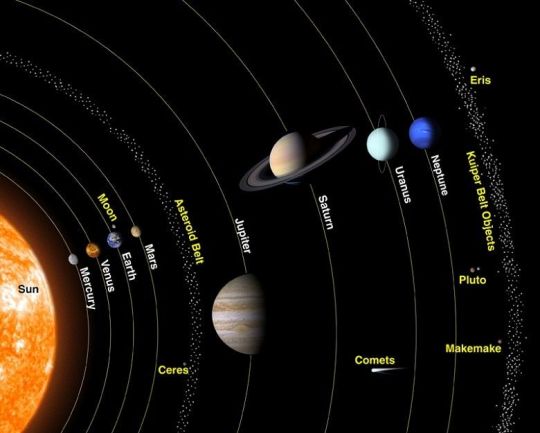
Planet is an astronomical object that is enough massive that it can get folded by its own gravity and is not massive that it can cause thermo-nuclear fusion. Planet rotates in its own axis (spinning) and revolves around sun too. It is in circular shape and has a core too. A few properties of the planets in our solar system are given here. Mercury: since it is near to sun so its surface temperature is 426.7 degree Celsius. However the opposite side to sun has temperature of 173 degree Celsius. Venus: due to density of atmosphere, air pressure on its surface is 90 times more than that of earth, making it not suitable for life. A planet of life, where we are living. Mars: it has red color, it is made up of rock and experiences many wind storms. Jupiter: it is largest of all planets. Saturn: it contains many asteroids which cause rings surrounding it. Uranus: its spinning axis is parallel to its orbit so seems to slide on axis. Neptune: it is farthest planet. Planets are categorized into 2 types. Terrestrials: they are small with low density and rocky. They include Mercury, Venus, Earth, and Mars. Giant: they are large in size and also known as gas giants including Jupiter, Saturn, Uranus, and Neptune. Stars
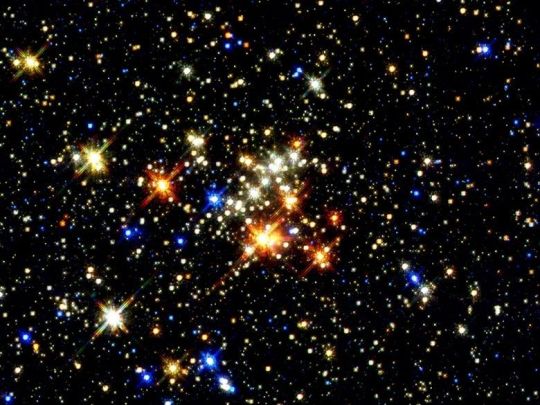
Star is a massive ball made of plasma that emits light throughout the space. Size, brightness, color, temperature and compositions are the points, on which properties of star can be determined. Stars are formed within the dust clouds and are scattered in most galaxies. The Orion Nebula is a familiar example of such a dust cloud. Now the question arises that how they shine? So let’s understand it, well it is too interesting… All stars, including sun are hot balloons of hot glowing plasma which is held together by its own gravity. Gravity of star is too intense and they are continuously crushing themselves inward. Now due to the gravitational friction, interior of star heats up. A star like sun has 5800 K temperature at its surface but temperature of core can be 15 million K. Due to this high temperature in core, nuclear fusion takes place where hydrogen atoms gets fused into helium atoms. As a result, an enormous amount of energy gets released in form of gamma rays. Against the gravitational contraction, gamma rays push the star outward as they are trapped inside star. This is the reason why stars don’t contract. Now these gamma rays jump outside after being absorbed by an atom. It happens many times in a second and a single photon takes 100,000 years to reach the surface of star from its core. So as they reach on surface, they have lost some of their energy, becoming visible photons instead of gamma rays, from which it was started. After being emitted from star, they travel in straight line in space and they can travel forever if they don’t run into anything. Moon

Moon is a body that is smaller than planets and revolves around planets. Moon is the natural satellite of our planet as earth has 1 moon, mars has 2 and Jupiter has 67 moons. It is the closest celestial body to earth. It is 239, 000 miles away from earth. It completes its one round around earth in 27.3 days. Since there is no atmosphere of moon so eve after years the dust present on surface of moon is in same position as before. Its size is ¼ of earth. Due to small mass and size, it has gravity that is 1/6 of earth’s gravity. That’s why you can jump on moon so high, because your body has only mass, it has no weight there. (W = mg) It is not a planet as it does not revolves around sun. It looks brighter in night because of the sun’s light reflected from it. Satellite

Satellite is defined as an object which is launched into space to orbit or can be defined as it is a moon, machine or planet which orbits a planet or star. As earth revolves around sun so it is a satellite, similarly moon revolves around earth so it is also. Both of them are natural satellites. However many artificial satellites have also been sent into space that are revolving around earth. The functions of these satellites can be different, some of them are used to take pictures of that planet which helps meteorologists to predict about weather and to monitor the cloud patterns. Pictures of other planets, black hole, dark matter and sun help scientist to understand solar system in better way. The path followed by a satellite is called orbit. Orbits can be at different altitudes and may have different rotation and orientation relative to earth. Satellites at higher altitudes of 36,000 Km facing same side of earth all the time are called geostationary satellites. Their speed is same as the rotation of earth so it seems to be stationary. This helps them to collect information over specific areas, continuously. Usually communication and weather satellites have this type of orbits. Galaxy
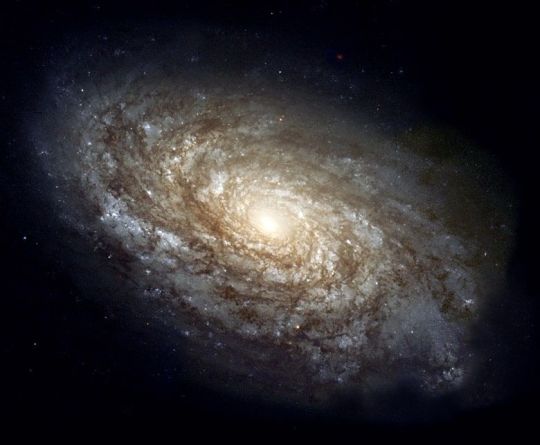
A galaxy is a huge collection of dust particles, gas and billions of stars and their solar systems. The thing that keeps galaxy bound, is its gravity. Our galaxy, Milky Way also has a super massive black hole in its core that causes gravity effect. In night, when you see stars on sky, then actually you see them in Milky Way. There are countless galaxies around us. You can get estimate of total number of galaxies by knowing that Hubble Space Telescope has seen 10,000 galaxies in a small patch of space in 12 days. Our galaxy is spiral shaped and it has curved arms which makes its look like pinwheel. Other galaxies are smooth and ovel shaped, called elliptical galaxies. Others are irregular shaped and look like blobs. Galaxies look bright, due to the brightness of the stars inside it. Light year Light year is the unit of distance and is defined as the distance travelled by light in one year. Since light travels at speed of 300,000 km/s, so in 1 year it can travel 10 trillion Km. So 1 light year = 9,500,000,000,000 Km. Actually this unit is used for very very large distances, because we are not discussing about cities or countries, we are discussing planets and stars. We appear to define distances in our solar system in terms of an Astronomical Unit (AU). The AU is known as the Earth's mean distance from the Sun. It is about 150 million km (93 million miles) away. It may be said that Mercury is about 1/3 of an AU from the Earth, and that Pluto is about 40 AU from the Earth. Asteroid belt
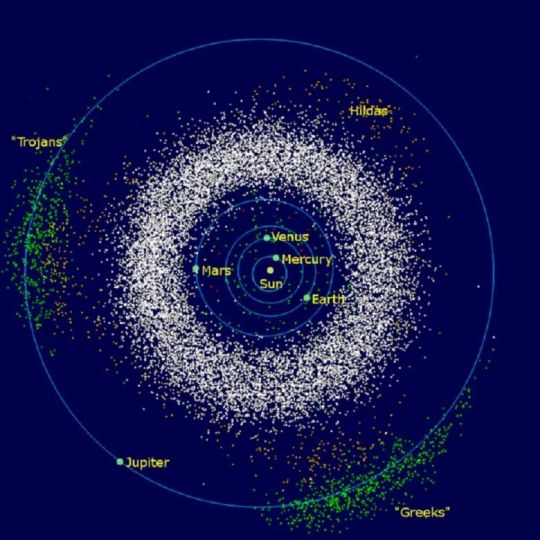
It lies between Mars and Jupiter. Asteroid belt is defined as a torus shaped (a surface that is generated by revolving a circle in 3D in the axis that is coplanar with circle) area in solar system which is located b/w the orbits of mars and Jupiter. This region contains solid and irregular shaped bodies that are smaller than planets, called asteroids. Kuiper belt

Kuiper belt, also known as edgeworth- Kuiper belt, is a disc in outer solar system which is extended from the orbit of Neptune to 50 Au of sun. It is similar to asteroid belt but it is more wider, 20 times wider and 20 to 200 times massive. It also consists of small bodies like asteroid belt. Since many asteroids are composed of rock and metal, so most objects of Kuiper belt are made of large frozen volatiles (named as ices) including methane, ammonia and water. Dwarf planets
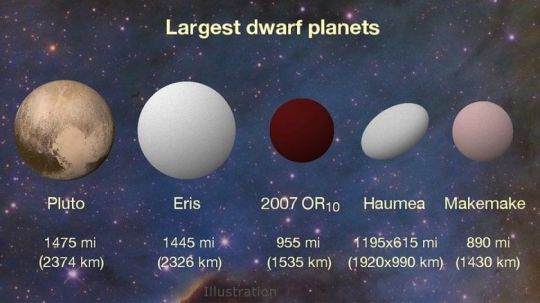
These are the massive objects that are not satellites and does not have any specific region in space, unlike other planets. It is in direct orbit of sun. They have sufficient mass for their self-gravity to overcome the forces of rigid bodies. Currently, five dwarf planets have been found. Ceres is located in the asteroid belt while remaining are present in or near to the Kuiper belt. Solar wind
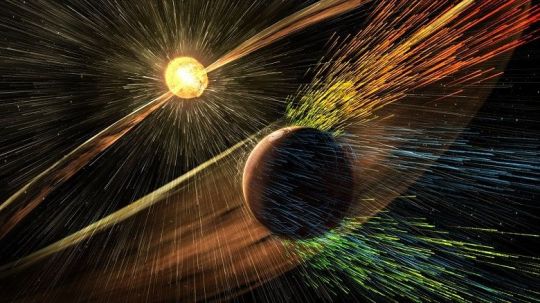
It is defined as a stream of charged particles that are released from the upper atmosphere of the sun, which is known as corona (it is the outer layer of sun, when it stretches far in space then its particles reach on the surface of earth). The stream with which solar wind is made up of, consists of electrons, protons and alpha particles having kinetic energy ranging from 0.5 to 10 KeV. Composition of solar wind also includes heavy ions and atomic nuclei like carbon, nitrogen, oxygen, neon, magnesium, silicon, sulphur and iron, in a little amount. Comet
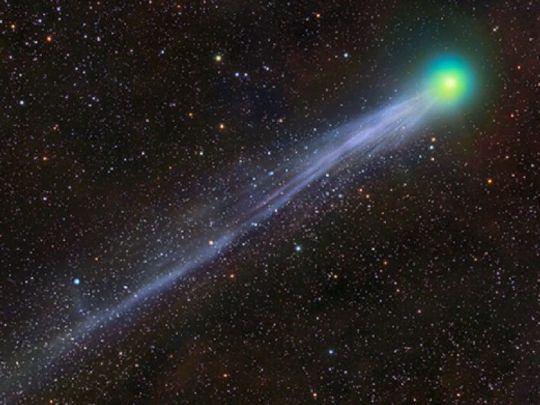
Comets are snowballs made of frozen gases, rock and dust and they orbit around sun. Initially its size is smaller, when it is in frozen state, but when it reaches near sun, it releases gas or dust due to the heat of sun. These emitted dust particles and gases made a tail that stretches away from sun for millions of miles. These icy bodies are also known as snowy dirtballs or dirty snowballs. They are composed of dust, ice, carbon dioxide, ammonia, methane and many more. Nebula

Nebula is a giant cloud of gas and dust present in space. Its plural is nebulae. Some nebula come from the dust and gas which is resulted by the explosion of a dying star. Nebula is also known as star nurseries as many stars are formed over here. They are found in the space b/w stars (interstellar space). The closest nebula to our earth is named as “Helix Nebula” which is approximately 700 light years away from us. Mean it will take 700 years to bring you there, if you can move with speed of light. Supernova A supernova is the largest ever observed eruption by humans. Each blast is a star's incredibly bright, super powerful blast. There are two types of supernova. One of them is caused by the death of a massive star. Massive stars have huge amount of fuels in their core/center which causes tons of energy, that’s why center is too hot. This heat produces pressure and this pressure prevents star o collapse. There is 2 types of force inside a star, both are opposite. Star’s gravity tries to make it smaller by squeezing it, as much possible, but the nuclear fuel in core, creates too pressure that produces strong outward pressure. When fuel ends in a massive star then it cools off due to which pressure also drops and gravity wins and star is dead. Second type of supernova occurs when two stars orbit one another and one of them is earth sized dwarf. Supernova event is so bright that they outshine entire galaxy for few days or even months and are visible across whole universe. Black holes
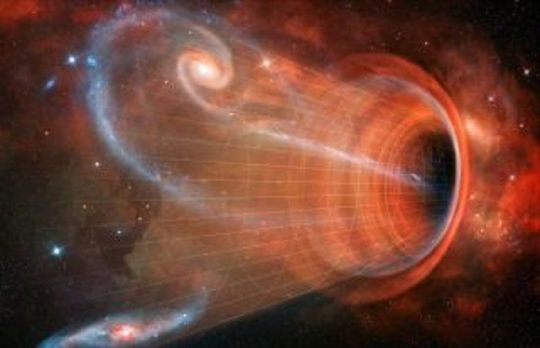
Black hole is defined as a place in space where grip of gravity is so strong that even light can’t come out of it. The reason of strong gravity is that matter has been squeezed into tiny space which happens during death of star. Black holes are invisible as no light can come out of them. They can be of different sizes. Small black holes can be of the size of an atom, since these are very tiny but have mass (amount of matter in object) equivalent to large sized mountain. Second type of black holes is termed as “stellar”. Their mass can be upto 20 times of sun or even more. Largest black hole is called supermassive with the mass of 1 million suns together. Research tells that our galaxy, Milky Way has a super massive black hole at its center named as Sagittarius A. Black hole does not vender in space to eat stars and planets. Moreover, our earth will not fall into black hole, because there is no black hole near o our earth in solar system. Dark matter
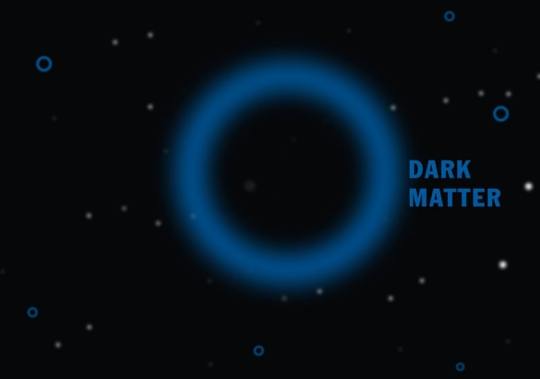
Dark matter is a substance with which 27 percent of universe is made up. It is invisible and it can’t emit, absorb or reflect any electromagnetic radiation like x rays and radio waves even light. It can interact with ordinary matter. This is fact due to which astronomers are able to make maps of its distribution even it is invisible. Falling star or meteoroids

A body moving in solar system that changes its identity and becomes meteor when it enters earth’s atmosphere. When a meteoroid enters in earth’s atmosphere at speed of 20 km/s then streak of light is produced due to aerodynamic heating. This streak of light is seen for both the glowing object and tail of glowing particles that it leaves. This phenomenon is called meteor or shooting star. If many meteors appears after seconds or minutes and appear to get originated from same point in sky then it is called meteor shower. Now if the object bears ablation and falls or touches ground then it is called meteorite. Falling star is nothing to do with star, it is just a term used to identify the meteor on sky. Do not forget leaving your valuable comment on this piece of writing and sharing with your near and dear ones. To keep yourself up-to-date with Information Palace, put your email in the space given below and Subscribe. Furthermore, if you yearn to know about Beta particle, view our construct, ‘Beta particle overview, beta decay, radioactivity of bananas.’ Read the full article
#Asteroid#Asteroidbelt#Blackhole#Comet#Darkmatter#Dwarfplanet#Earth#Galaxy#Giantplanet#Gravity#Jupiter#Kuiperbelt#Light#Lightyear#Mars#Matter#Mercury#Meteor#Meteorite#Meteoroid#Milkyway#Moon#Nebula#Neptune#Planets#Pluto#Satellite#Saturn#SolarSystem#Solarwind
0 notes
Text
MG Motor India to unveil game-changing Comet EV on April 26th, setting new standards for affordable and stylish electric city cars!
🚗🔌 Get ready to meet the Comet EV, MG Motor India's latest game-changer in the electric car market! 🌟 With its unique design and features. Stay tuned for more updates and get ready to experience the future of mobility! 🔋⚡ #MGCometEV #ElectricCars
MG Motor India is set to launch the Comet EV, a two-door electric city car, on April 26th, with prices to be revealed in May 2023. The Comet EV will offer unique exterior packages, dual 10.25-inch infotainment screens, and a capacity of around 20kWh, with a claimed driving range of over 200km on a single charge. image source :Zeenews MG Motor India will introduce the new Comet EV on April 26,…

View On WordPress
#auto news#INDIA#mg comet ev#mg comet ev india#mg comet ev interior#mg comet ev price#mg comet ev price in india#mg comet ev range#NEWS
0 notes
Text
MG Electric Car Price in Chennai: Affordable Green Mobility
Indian EV demand is on the rise and, in Chennai, that growth has been boosted by the city’s growing appetite for green mobility solutions. MG Motor is among the top EV players in the market with its premium features, reliable performance and best price. If you are looking for the MG electric car price in Chennai, this guide covers details you need to know in order to make an informed decision.
So, Why choose MG Electric Car?
MG Motor’s electric cars promise a perfect balance of performance, technology and sustainability. Here’s why they stand out:
Eco-Friendly: MG electric cars do not emit anything as they are environmentally friendly.
Cost Efficiency: Owning an EV costs much less owing to reduced fuel and maintenance costs in the long run.
Advanced Features: Connected car tech, voice assistance and advanced safety systems come wrapped up with MG EVs as smart features.
Stylish Design: The modern exteriors and luxurious interior MG electric cars promise provide up to date looks.
Here you will find the MG Electric Car Models and Prices in Chennai.
MG Motor offers two popular electric car models in Chennai: The MGZS EV, as well as the MG Comet EV. Here’s a closer look at their pricing and features:
MG ZS EV:
Price: With a starting price of ₹23 lakh (ex-showroom).
Range: It’s the first model from Tesla to offer an impressive range of up to 461 km on a single charge.
Features: In addition to three airbags, 360-degree camera, and 10.1-inch touchscreen infotainment system, this premium electric SUV also has a panoramic sunroof.
Ideal For: Those who know that space and comfort are a priority to families and long distance travellers.
MG Comet EV:
Price: The company has started selling New K2K from ₹9 lakh (ex-showroom).
Range: It was designed as an urban commuting car, boasting a useful range daily city runs.
Features: It’s designed compact, has connected car technology and is extremely manoeuvrable, making it a perfect fit for manoeuvring Chennai's congested roads.
Ideal For: Employees, young professionals and urban commuters who require an affordable EV but who also want style.
The On Road Price in Chennai is effected by the following factors.
When calculating the on-road price of an MG electric car in Chennai, consider the following factors:
Road Tax and Subsidies: EVs are also made more affordable by government of Tamil Nadu offering incentives and reduced road tax.
Insurance Costs: The model and coverage chosen make a difference in insurance premiums.
Additional Costs: The price will be adjusted according to accessories, home charging solutions and extended warranties.
Chennai is perfect for MG Electric Cars, but Why?
Chennai has the right EV infrastructure and government support to possess an MG electric car. Here are some benefits:
Expanding Charging Network: More and more public charging stations are rising and recharging your EV is a hassle free and convenient process.
Sustainability Goals: By driving an MG EV, we are adding to our mission of reducing air pollution, and at the same time realizing the city’s green mobility vision.
Government Incentives: By obtaining subsidies and tax benefits you can make the purchase cheaper.
Conclusion
Being an eco-friendly car which provides premium quality without sacrificing features, the MG electric car price in Chennai is ideal for seekers such as yourself. You can opt for a bigger package in the form of the MG ZS EV or go for the smaller in size MG Comet EV which will take you a step closer to a greener planet. Come visit an MG showroom in Chennai today and know the latest prices of the car, and put the future of mobility in your hands with MG electric cars. Drive sustainably for far less than you might think!
0 notes
Text
Exclusive Look Inside MG's Upcoming Comet EV: Futuristic Interior Design and Cutting-Edge Features Unveiled
🚀 Ready to experience the future of driving? Check out the first interior image of MG Motor's upcoming Comet EV! 😍 ⚡️ #MGCometEV #ElectricCars #FutureOfDriving #SustainableLiving 🌱🚗💨
MG Motor’s upcoming electric car, the Comet EV, is based on the Wuling Air EV sold in Indonesia and is set to be a premium intra-city runabout with a minimalist interior theme and a range of up to 250km. The Comet EV will feature a two-spoke steering wheel, a dual-screen setup with two 10.25-inch screens, connected car features like Android Auto and Apple CarPlay, and a 20kWh battery sourced…

View On WordPress
#auto news#electric car#mg comet ev#mg comet ev interior#MG Comet ev interior features#mg comet ev price#mg electric car#NEWS#upcoming mg car
0 notes
Text
MG's New Electric Comet Set to Blaze through City Streets as the Ultimate Runabout
MG Motor has just revealed that its upcoming compact EV will be known as the 'Comet' in India. Know more #MG #electricvehicles #CometEV #cityrunabout #urbanmobility #greenvehicles #EVrevolution #sustainabletransportation #motogadi #MGCometev #electriccar
The Comet EV is designed to be a city runabout, making it a practical and eco-friendly choice for drivers who live in urban areas with driving range of 300KM. MG Motor has just revealed that its upcoming compact EV will be known as the ‘Comet’ in India. This is also the first time MG has shown off the India-spec model, which is based on sister brand Wuling’s Air EV and is sold in markets such as…

View On WordPress
#comet ev#electric car#mg comet driving range#mg comet ev#mg comet ev interior#mg comet ev launch date#mg comet ev price#mg comet ev price in india#mg comet ev range#mg comet interior#mg comet price#new mg car
0 notes
Text
MG Electric Car in Chennai: A Future of Sustainability through Driving
Chennai is witnessing a revolution in the automotive industry which Electric vehicles (EVs) are leading. MG Motor is one of the leading players in the EV sector owing to its electric cars loaded with both innovation and features. Here is everything you need to know if you are contemplating the idea of purchasing an MG electric car in Chennai.
Why an MG Electric Car?
The vehicle’s MG Motor’s electric vehicles are not only the futuristic but also blending of the ground-breaking technology, environmentally friendly and trendy. Here are some key reasons to consider an MG electric car:
Zero Emissions: Help keep the environment cleaner by driving a tailpipe emissions free car.
Lower Running Costs: Running an EV is more economical than running traditional fuel powered ESVs, due to lower fuel and maintenance costs.
Advanced Features: Smart features like connected car technology, voice commands and a premium infotainment system are what you get in MG electric cars.
Stylish Design: Its modern exteriors and luxurious interiors make MG electric cars bale out on busy streets of Chennai.
Popular MG Electric Cars available in Chennai
MG Motor comes up with a stellar line-up of an electric car tailored to different needs and requirement of different users. Here’s a closer look:
MG ZS EV:
Price: It begins from ₹23 lakh (ex-showroom) onwards.
Range: It offers absolutely astonishing range of up to 461 km on a single charge.
Features: This electric SUV has a panoramic sunroof, a large touchscreen infotainment system, and a 360 degree camera as well as advance safety features like multiple airbags.
Ideal For: Long-range, families and long distance travellers seeking premium and spacious electric SUV.
MG Comet EV:
Price: Starting at ₹9 lakh (ex showroom).
Range: It’s designed for urban commuting, as it’s a practical range for your daily city drives.
Features: It’s a compact design with easy manoeuvrability, and it comes with connected car technology, great for city dwellers.
Ideal For: Young professionals, urban commuters of Chennai’s traffic.
Top Advantages of an MG Electric Car in Chennai
Government Incentives: Tamil Nadu’s government has its own incentive to promote adoption of EV in state as they are offering subsidies and other such financial benefits.
Charging Infrastructure: MG electric vehicles have no dearth of convenience as Chennai accelerates its network of EV charging stations.
Sustainability: Having an MG electric car is a perfect match to the vision of the city towards implementing green mobility and cutting pollution.
Cost Savings: It’s an economical option compared to other vehicles for it offers substantial fuel and maintenance savings.
Mag Swaraj advises seeking help from MG Expert from the Electrical Cars category to get the best out of your electric automobile. The professional from MG will guide you in using the auto fully and will suggest the best product for you within your budget.
Chennai is embedded with a strong dealership network for MG Motor. It has popular dealership locations spread across Anna Salai, OMR, Velachery, and Ambattur as well. Test drives, financing options and the potential of expert guidance, all come as part of the package when you visit these showrooms to buy their MG electric car.
Conclusion
An electric motor car from MG in Chennai is a great choice for the one looking to buy a car that is the modern amalgamation of economic, eco-friendly, and stately. From the generous space of the MG ZS EV to the compactness of the MG Comet EV, there’s definitely something for everyone in MG Motor’s line-up. If you are in Chennai, visit your nearest MG dealership today and check out their range, take a test drive and take a step closer to a greener tomorrow. MG electric cars offer a more future forward journey, we want to be a part of ushering in the future of mobility.
0 notes